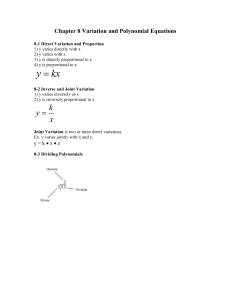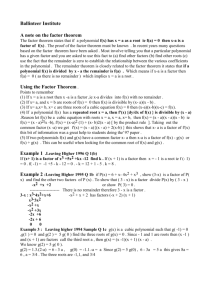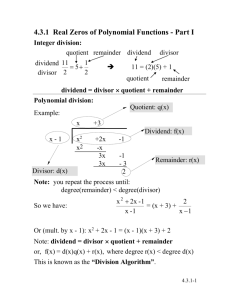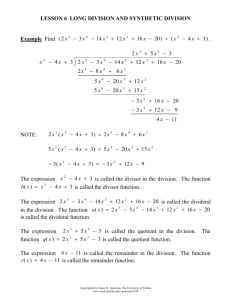3-7 The Real Zeros of a Polynomial Function
advertisement
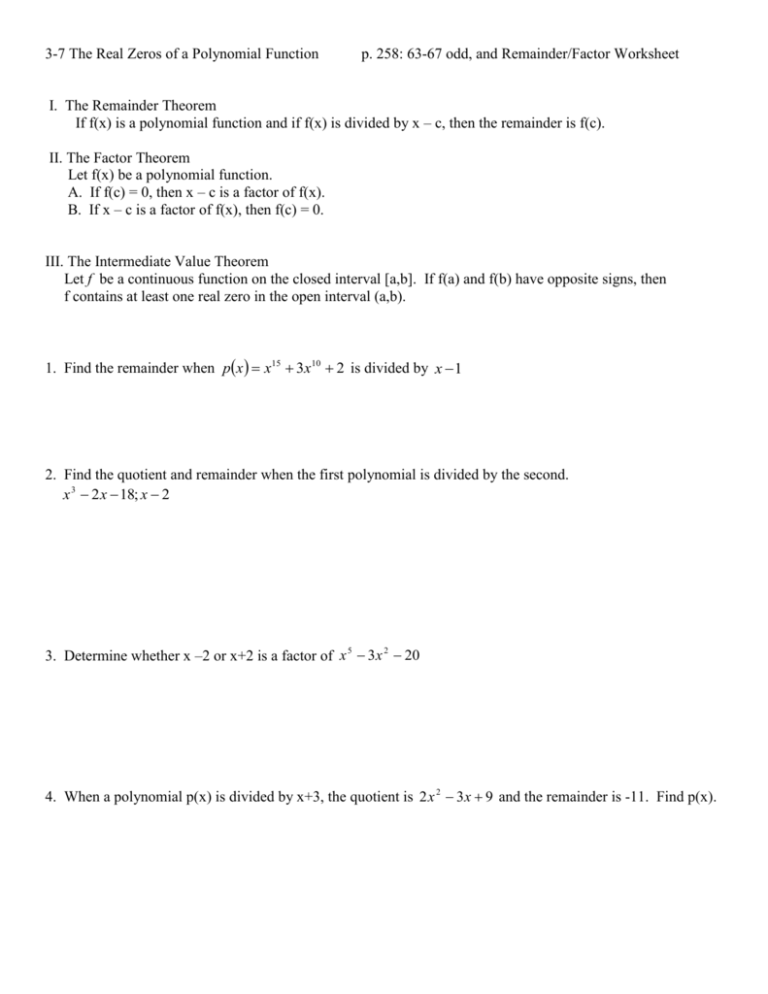
3-7 The Real Zeros of a Polynomial Function p. 258: 63-67 odd, and Remainder/Factor Worksheet I. The Remainder Theorem If f(x) is a polynomial function and if f(x) is divided by x – c, then the remainder is f(c). II. The Factor Theorem Let f(x) be a polynomial function. A. If f(c) = 0, then x – c is a factor of f(x). B. If x – c is a factor of f(x), then f(c) = 0. III. The Intermediate Value Theorem Let f be a continuous function on the closed interval [a,b]. If f(a) and f(b) have opposite signs, then f contains at least one real zero in the open interval (a,b). 1. Find the remainder when px x15 3x10 2 is divided by x 1 2. Find the quotient and remainder when the first polynomial is divided by the second. x 3 2 x 18; x 2 3. Determine whether x –2 or x+2 is a factor of x 5 3 x 2 20 4. When a polynomial p(x) is divided by x+3, the quotient is 2 x 2 3 x 9 and the remainder is -11. Find p(x). Given a polynomial and one or more of its roots, find the remaining roots. 5. 2 x 3 5 x 2 23x 10 0; root x 2 6. 2 x 4 5 x 3 8x 2 17 x 6; roots x -1and x 2 Use the Intermediate Value Theorem to show that each function has a zero in the given interval. Approximate the zero rounded to three decimal places. 7. f ( x) x 3 3x 1; [0,1] 8. f x 2 x 4 x 3 6 x 3 ; [1,2] Descartes Rule of Signs Chapter 3 Polynomials/Descartes Worksheet I. Descartes Rule of Signs Let p(x) be a polynomial: A. The number of positive real zeros equals the # of sign changes in p(x) or the number of sign changes minus two. B. The number of negative real zeros equals the # of sign changes in p(-x) or the number of sign changes minus two. II. Upper Bound Theorem If p(x) is divided by x – c and there are no sign changes in the quotient or remainder, then c is upper bound. III. Lower Bound Theorem If p(x) is divided by x + c and there are alternating sign changes in the quotient and the remainder, then -c Is the lower bound. IV. The Fundamental Theorem of Algebra A polynomial function of degree n has at most n real zeros. V. Rational Roots Theorem If f ( x) qx n cx n1 ... c1 x p , then factors of p are possible rational zeros of f where the q coefficients of f are integers. Use Descartes Rule of signs to summarize the number of positive, negative, and imaginary roots of each polynomial equation. 1. 2 x 4 x 3 7 x 2 4 x 1 0 2. x 3 6x 2 1 0 Find the upper and lower bound of each polynomial equation and then state the interval in which the roots lie. 3. 2 x 4 x 3 7 x 2 4 x 1 0 4. 2 x 3 x 2 28x 51 0 Solve each equation, giving all real and imaginary roots. (Remember: Some of these may factor) 5. x 4 2 x 3 2 x 2 6 x 3 0 6. x 3 x 2 x 1 0 7. 3x 4 5 x 2 2 0 8. 3x 3 4 x 2 5 x 2 0 9. x 4 2 x 3 x 2 4 x 2 0 3-6 Polynomial Inequalities Polynomial and Rational Inequalities Worksheet I. Solving Polynomial Equations A. Collect all terms to one side compared to zero B. Factor and solve for x C. Perform an interval line test to find the desired values of positive or negative D. Express the solution set in interval notation Solve each inequality 1. x 1 x 3 0 2. x 2 3x 0 4. 2 x 2 3x 5 5. x x 5 14 6. 7. x 3 4 x 2 8. x 4 4 x 2 5 0 9. x 3 2 x 2 15x 0 b gb g ( x 2)( x 5) 2 0 10. ( x 1) 2 b g 3. x 2 16 0 bx 2gcx 6x 9h 0 2




